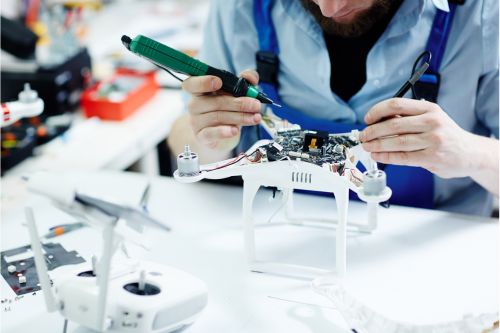Table of Contents
All about mechatronics | Introduction
Mechatronics is a multidisciplinary field that combines principles of mechanical, electrical, and software engineering to design and control advanced systems. Mechatronics has become increasingly important in the modern world, as it allows for the creation of complex systems that can perform a variety of functions. In this article, we’ll explore the history of mechatronics, its key concepts, applications, future potential, and career opportunities.
History of mechatronics
Mechatronics originated in Japan in the 1960s, as a response to the need for more efficient and automated manufacturing processes. The term “mechatronics” was coined by Tetsuro Mori, a senior engineer at the Japanese company Yaskawa Electric Corporation, who recognized the need for a new field that combined mechanical, electrical, and software engineering. Mechatronics was further developed in the 1970s, as the use of microprocessors and computers became more widespread. Today, mechatronics has become an essential field in many industries, including automotive, aerospace, robotics, and automation.
Key concepts of mechatronics

This field combines knowledge from various fields to create advanced systems. Mechanical systems, such as motors, gears, and sensors, are used to create the physical components of the system. Electrical systems, such as circuits and power sources, provide the necessary energy for the system. Computer systems, such as microprocessors and software, are used to control and coordinate the various components of the system. The integration of these systems is a key concept in it, as it allows for the creation of complex systems that can perform a variety of functions.
Applications of mechatronics
Mechatronics has many applications in various industries. In robotics, it is used to create robots that can perform tasks that are difficult or dangerous for humans. Industrial automation uses mechatronics to create systems that can operate manufacturing processes with greater efficiency and precision. The automotive industry uses it to create systems such as anti-lock brakes, airbags, and cruise control. The medical industry uses this field to create medical devices such as prosthetics and imaging systems. Consumer electronics, such as smartphones and smart home devices, use this field to create advanced systems that can respond to user inputs. The aerospace industry uses it to create systems such as autopilots and flight control systems.
Future of mechatronics

The future of mechatronics looks promising, as emerging technologies such as artificial intelligence, the Internet of Things (IoT), and automation are expected to increase the demand for this field professionals. It is also expected to have a significant impact on society, as it allows for the creation of advanced systems that can improve people’s lives. For example, It can be used to create medical devices that can diagnose and treat diseases more accurately and efficiently. This can also be used to create sustainable energy systems that can reduce our dependence on fossil fuels.
Education and career in mechatronics
Mechatronics is a field of engineering that integrates mechanical, electrical, and computer engineering to create smart systems. This interdisciplinary field is rapidly growing and has applications in a variety of industries, including manufacturing, automotive, aerospace, healthcare, and entertainment.
To pursue a career in this field one must have a strong foundation in mathematics, physics, and computer science. Additionally, courses in mechanics, electronics, control systems, and robotics are necessary to become a successful engineer.
Students can pursue education in this field at various levels, including diploma, undergraduate, postgraduate, and doctoral. Most universities offer programs that combine theory and practical learning through project work, industry visits, and internships. The curriculum typically includes courses in mechanics, electronics, control systems, robotics, computer science, and mathematics.
After obtaining a degree in it, graduates can explore various career opportunities in the field. They can work in a wide range of industries and job titles may include robotics engineer, automation engineer, control systems engineer, mechatronics engineer, and more. Engineers design and develop systems that integrate mechanical, electrical, and computer engineering to create smart machines that can operate on their own or with human input. They work with teams of engineers and scientists to research, design, and develop new technologies.
The demand for this branch engineers is increasing rapidly due to the rise of automation and smart machines. Many companies are looking for engineers who can design and develop intelligent systems that can operate on their own. With the increasing demand for automation and smart machines, graduates of this field are well-positioned to find lucrative and rewarding careers in a variety of industries.
Read more: Automation in Education
Key takeaways
- Mechatronics is a rapidly growing field that combines principles of mechanical, electrical, and software engineering to create advanced systems.
- It has many applications in various industries, including robotics, industrial automation, automotive, medical, consumer electronics, and aerospace.
- With the increasing demand for automation and smart machines, graduates of this field are well-positioned to find lucrative and rewarding careers in a variety of industries.
Did you find this blog helpful? Do share your perspectives about the blog in the comments below. Please get in touch with us by clicking here for more information. We would be happy to assist you with your queries.
Liked this blog? Read next: Grand Valley State University | Your A-Z guide to studying here!
FAQs
Q1. What is the difference between mechatronics and robotics?
Answer: Mechatronics is the integration of mechanical, electrical, and computer engineering to create smart systems. Robotics is a subset of mechatronics that deals specifically with the design and development of robots.
Q2. What kind of courses do I need to take to study mechatronics?
Answer: Mechatronics students will typically take courses in mechanics, electronics, control systems, robotics, computer science, and mathematics.
Q3. What kind of career opportunities are available for mechatronics graduates?
Answer: Mechatronics graduates can work in a wide range of industries, including manufacturing, automotive, aerospace, healthcare, and entertainment. Job titles may include robotics engineer, automation engineer, control systems engineer, mechatronics engineer, and more.






